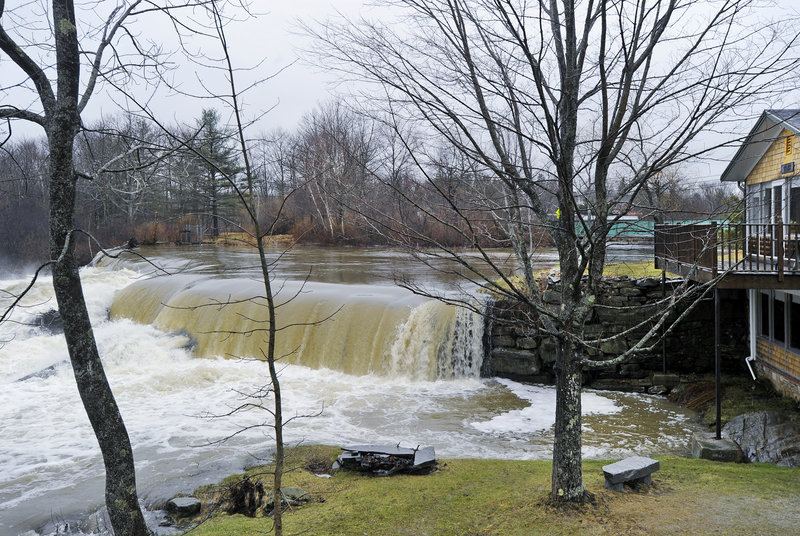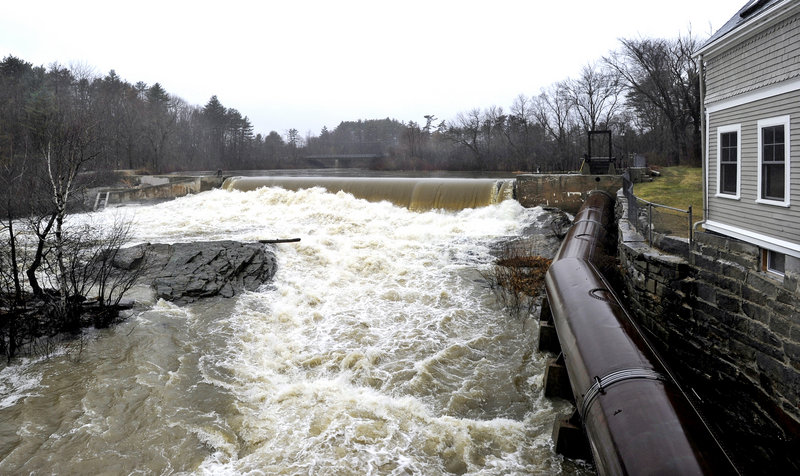There have been dams on the Royal River since Europeans first settled in Yarmouth in the 1600s.
the 1800s, the dams were powering textile and paper mills in Yarmouth’s thriving industrial center. Those industries shut down years ago, and now the community is considering removing the two dams that remain on the river.
Removal of the dams would be great for anadromous fish such as alewives, which have been blocked from spawning grounds upriver. For people who swim and boat in the river, the change may not be so positive.
“It is an extremely sensitive issue in this community,” said Henry Nichols, executive director of the Royal River Conservation Trust, which has taken no position.
A meeting is set for 7 tonight at the Log Cabin, with town officials, environmental consultants, National Oceanic and Atmospheric Administration representatives and others kicking off an examination of the pros and cons of restoring the river to a more natural state.
The Royal River dams at Bridge Street and East Elm Street have been owned by the town since the 1970s. The East Elm Street dam, a stone structure built in the 1800s, serves mainly as an impoundment, keeping river levels high in the summer.
The town leases out the Bridge Street dam to the Sparhawk Mill, which generates electricity with three turbines that shut down during dry spells. The turbines generate about 850,000 kilowatts a year, enough to power the mills’ tenants and generate some sales to the grid.
Both dams have fish ladders, which most agree are ineffective in allowing fish upriver, if they work at all. The Royal River has been identified as a restoration priority by the State Planning Office and the Gulf of Maine Council.
Last year, a committee appointed by the Town Council issued a master plan for the river, which is a focal point for Yarmouth because of its heavily used walking paths and swimming holes along the shoreline.
The town then got $32,000 from the Conservation Law Foundation and NOAA to look at the possibilities of returning anadromous fish to the river, which would require dam removal or enhancements to the fish ladders. The town hired Stantec Consulting Services in Topsham to do the study.
“We are going to let the data inform policy,” said Town Manager Nat Tupper.
Tupper said the dams’ future is just one question the town is trying to answer as it tries to improve the habitat of the river, which flows out of Sabbathday Lake in New Gloucester on a roughly 30-mile course to Casco Bay.
Interest in the river’s future is extremely high in Yarmouth, and opinions about what to do with it are mixed.
Landis Hudson, executive director of Maine Rivers, a statewide group based in Yarmouth that focuses on improving river habitat, said the idea of removing the dams is intriguing.
“People are increasingly aware that the restoration of rivers has value,” Hudson said.
Alan Dugas, third-generation owner of the Royal River Boatyard, said he wants the river to remain just as it is.
Dugas, who served on the river master plan committee, said he is worried that changes such as dam removal would lower the water, clog the channel with trees and other debris and increase silt in the harbor at the mouth of the river.
“Stuff has been that way for a long, long time. Why change?” Dugas said.
Tupper said tonight’s meeting is just the beginning of a long conversation about what to do about the river. If the town ever decides to move ahead with dam removal, there will be studies to look at the costs and the hydrological and environmental impacts.
Tupper said there will be meetings for the public to weigh in before the study is complete and recommendations are presented during the summer.
Meanwhile, the public has a chance to get to know the river. In late April, the Royal River Conservation Trust will sponsor a first-of-its-kind two-day paddle from the head of Sabbathday Lake to Yarmouth.
Nichols said that outside downtown Yarmouth, the river is largely hidden from view and unused. The paddle will probably involve many portages around downed trees and other blockages.
“It will be muddy and dirty,” he said, “but we will have a much better idea of what this river looks like from the river itself.”
Staff Writer Beth Quimby can be contacted at 791-6363 or at: bquimby@pressherald.com
Send questions/comments to the editors.





Success. Please wait for the page to reload. If the page does not reload within 5 seconds, please refresh the page.
Enter your email and password to access comments.
Hi, to comment on stories you must . This profile is in addition to your subscription and website login.
Already have a commenting profile? .
Invalid username/password.
Please check your email to confirm and complete your registration.
Only subscribers are eligible to post comments. Please subscribe or login first for digital access. Here’s why.
Use the form below to reset your password. When you've submitted your account email, we will send an email with a reset code.